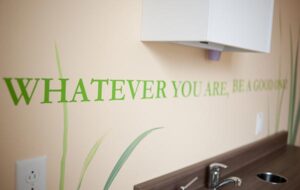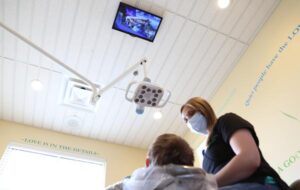Preventative pediatric dental care
Establishing healthy dental habits for growing grins
Our preventative care routine
New patients are typically seen in our open-concept hygiene bay with other children present. This gives younger children an opportunity to observe others who are comfortable getting children’s dental care. It also allows siblings to stay together.
We’ve found that another benefit of this setup is that it creates a less intimidating environment for kiddos who are anxious or fearful about going to a pediatric dentist.
You’ll be encouraged to come back with your child and participate in their care.
What happens during a routine pediatric dental care check-up
- Your child will receive a professional comprehensive exam that includes proper nutritional and dietary counseling, brushing, and flossing technique review, as well as completing a risk assessment to identify your child’s contributing factors for dental cavities.
- The comprehensive exam is followed by an evaluation of your kid’s growth and development. We’ll also discuss any oral habits your little one might have.
- Then, we’ll place a professional application of fluoride on your child’s teeth.
- We finish by giving you a chance to discuss any pediatric dental care questions that you might have about your kiddo’s smile.
Learn about what to expect when you visit →
Age-by-age guidelines
When it comes to pediatric dental care, we believe that the involvement of parents is crucial for establishing good dental hygiene practices. And that involvement starts as early as infancy. Use the following recommendations as a guideline and bring any questions you have to your child’s next dental appointment.
For infants
Start the routine early! We encourage you to clean your infant’s gums each night with a wet washcloth or an infant finger toothbrush.
For toddlers
Once teeth appear, brush your child’s teeth twice a day with a soft-bristled toothbrush.
The American Dental Association and the American Academy of Pediatric Dentistry recommend fluoride toothpaste—just enough to cover two or three bristles, the amount of a grain of rice.
For children ages 3–5
Around 3-5 years old let your child start brushing on their own, but supervise and possibly help a bit on the hard-to-reach areas. The area most likely to be missed is behind the back molars and around the gum line.
Start focusing on brushing for two minutes and once all the teeth are in, and make flossing part of your routine.
For children ages 7–10
At this age, kids are usually handling regular pediatric dental care easily.
If you have a “non-brusher” on your hands, try a toothpaste called Plaque HD. This toothpaste helps the child identify areas where plaque has accumulated and gives them a visual cue for where they need to brush.
Dr. Diana will also help parents check the thoroughness of their brushing.
For children with braces
Kids with braces often have unique challenges when faced with attempting to maintain their oral hygiene.
For our patients who are learning to care for their teeth with orthodontic appliances, we offer complimentary oral hygiene-focused visits to help establish pediatric dental care techniques that keep their teeth clean and healthy while they have braces.
For pre-teens and teens
This is the point where most baby teeth are gone and kids have to keep their permanent, adult teeth in good shape. If there are hygiene issues, we work with each child individually to figure out an approach to pediatric dental care that is workable and maintainable for them.
Does your child need dental work for a problem?
Learn more about our dental treatment options.



